
- Usage in publication:
-
- Bishop tuff
- Modifications:
-
- Named
- Dominant lithology:
-
- Tuff
- AAPG geologic province:
-
- Great Basin province
Summary:
Pg. 1833-1860. Bishop tuff. Name applied to welded rhyolite tuff having areal extent of 400 to 450 sq mi and average thickness of 400 to 500 feet. In upper parts, pumice lapilli are imbedded in porous vitric-crystal matrix. Thick sections show structural and textural gradation from top to bottom, wherein, at base vitric constituents are compressed, distorted, and aligned in the horizontal plane, and structure becomes very compact; sorting poor; bedding conspicuously absent; well-developed columnar jointing is distinctive feature. In Owens River Gorge, overlies Sherwin till; to the west of Mono Craters underlies Tahoe till. Age is fixed by relation to Pleistocene moraines.
[Named from town of Bishop, southeast of Mono Lake, east-central CA.]
Source: US geologic names lexicon (USGS Bull. 1200, p. 352-353); supplemental information from GNU records (USGS DDS-6; Menlo GNULEX).
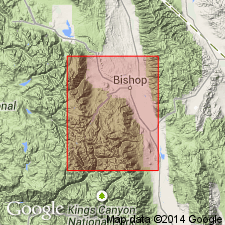
- Usage in publication:
-
- Bishop tuff*
- Modifications:
-
- Adopted
- AAPG geologic province:
-
- Great Basin province
Summary:
Bishop tuff (Gilbert, 1938) is adopted. Type locality is Gilbert's section in Owens River Gorge, sec.22 T5S R31E, north boundary of Mount Tom 15' quad, Mono Co, CA. Section did not include basal thin pumice layer which is best exposed along south and east sides of Volcanic Tableland. Principal tuff [upper] member is composed of "agglutinated" tuff that varies considerably in color, specific gravity, and texture. K-Ar age of 870,000 yr P.B. was obtained by Evernden and others (1957); D.G. Dalrymple (oral commun., 1964) indicated 0.7 Ma is better figure.
Source: GNU records (USGS DDS-6; Menlo GNULEX).
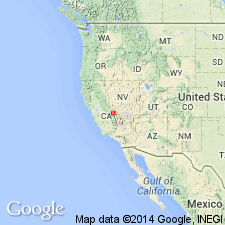
- Usage in publication:
-
- Bishop Tuff*
- Modifications:
-
- Geochronologic dating
- AAPG geologic province:
-
- Great Basin province
Summary:
New K-Ar determinations on 3 samples of sanidine from Bishop Tuff yielded age range from 0.639 +/-0.07 to 0.754 +/-0.08 Ma. All 103 samples are normally magnetized [Brunhes Normal-Polarity Chron].
Source: GNU records (USGS DDS-6; Menlo GNULEX).
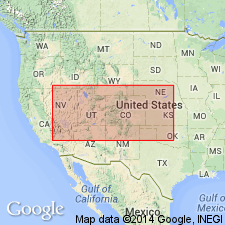
- Usage in publication:
-
- Bishop Tuff*
- Modifications:
-
- Areal extent
- AAPG geologic province:
-
- Great Basin province
Summary:
Sketch map shows location of samples from 11 localities scattered from California to south-central Nebraska. These match petrographically coarse air-fall pumice at base of Bishop Tuff. Referred to informally as Bishop ash bed. Lies stratigraphically below type O Pearlette-like ash at five localities. Bishop as bed (K-Ar age of about 0.7 Ma) is considered important marker bed "across several geomorphic provinces".
Source: GNU records (USGS DDS-6; Menlo GNULEX).
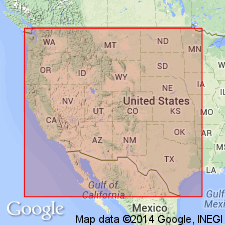
- Usage in publication:
-
- Bishop Tuff*
- Modifications:
-
- Age modified
- Geochronologic dating
- Paleomagnetics
- AAPG geologic province:
-
- Great Basin province
Summary:
17 new K-Ar determinations of the Bishop Tuff were made. Authors believe best K-Ar age on sanidine for Bishop is 0.738 +/-0.003 m.y. Brunhes Normal Polarity Chronozone boundary may be close to 0.75 m.y.--this is based on the K-Ar age of Bishop, the fact that Bishop has normal magnetic polarity, the ages of the reversely magnetized domes in the Jemez Mountains of NM, and the fact that the Matuyama and Brunhes boundary occurs 65 cm below the Bishop ash in sediments of ancient Lake Tecopa and 183 cm below Bishop in sediments of ancient Lake Bonneville. Eruption of Bishop ash covered more than a million sq km of western U.S.--distal ash beds found in localities in CA, ID, NV, UT, CO, NE, NM, and WY. Tephra beds informally named in this report are: Taylor Canyon-U bed that occurs near Benton Hot Springs, CA, and the Glass Mountain-T and Glass Mountain-U beds that are about 7 km northwest of Bishop, CA. 11 older tephra units occur in Bishop's volcanic field; 6 older tephra units originating in its field occur in CA, NV, and UT. Discusses chemical and mineralogical criteria for identification and correlation of ash beds. Contains compilation of localities in western U.S., a map showing distribution of ash beds and their inferred original extent, and a stratigraphic column showing Bishop ash beds and other late Cenozoic ash beds of western U.S. This is a basic report in dealing with the correlation of regional ash falls.
Source: GNU records (USGS DDS-6; Denver GNULEX).
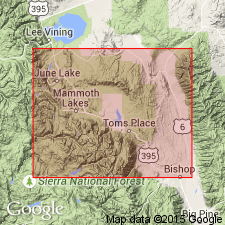
- Usage in publication:
-
- Bishop Tuff
- Bishop pumice and ash (informal)
- Bishop ash bed (informal)
- Modifications:
-
- Age modified
- Geochronologic dating
- AAPG geologic province:
-
- Great Basin province
Summary:
Precise dating of sanidine from proximal ash flow Bishop Tuff and air fall Bishop pumice and ash, California, yielded an average age of 758.9 +/-1.8 ka. Matuyama Reversed-Brunhes Normal (M-B) paleomagnetic transition, identified stratigraphically close beneath the Bishop Tuff and ash at many sites in the western U.S, has an average age of 774.2 +/-2.8 ka, similar to that determined from the astronomically tuned polarity timescale.
Source: Publication.
For more information, please contact Nancy Stamm, Geologic Names Committee Secretary.
Asterisk (*) indicates published by U.S. Geological Survey authors.
"No current usage" (†) implies that a name has been abandoned or has fallen into disuse. Former usage and, if known, replacement name given in parentheses ( ).
Slash (/) indicates name conflicts with nomenclatural guidelines (CSN, 1933; ACSN, 1961, 1970; NACSN, 1983, 2005, 2021). May be explained within brackets ([ ]).

